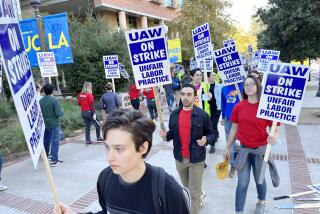Power Plant Urged for Site Next to Parkland
In a state running on fumes, the Baldwin Hills would seem the perfect spot for a new power plant.
They provide rare open space in the urban plain. Homes sit a good half-mile away. And oil pumps have already degraded parts of the area for 70 years.
So under the governor’s emergency power orders, Stocker Resources applied this month to build a 53-megawatt power plant in the hills. The problem is that the oil field also sits in the middle of the recently created Baldwin Hills Conservancy and is a key parcel in an effort to patch together 1,200 acres of green space for the densely packed neighborhoods of South Los Angeles.
“It would sit directly next to the main entrance of a world-class park for which $50 million has been invested in the last two years,” said Esther Feldman, president of Community Conservancy International, the main organizer working to save the hills.
Many people in Los Angeles’ urban park movement knew this controversy would hit somewhere. Throughout the city, conservationists have quietly expressed concerns that the power crisis was going to cut into their funds and railroad a burgeoning effort that doesn’t have the immediacy of rolling blackouts. Now, some are gearing up for their first battle: the fight to save the oil fields.
“This is not a ‘not in my backyard’ issue,” said Assemblyman Herb Wesson (D-Culver City), who has pushed for the park, which is in his district. “If there was place to put this just across the street or somewhere else in my district, I would do that.”
Other local legislators, including state Sen. Kevin Murray (D-Culver City), and Gov. Gray Davis have expressed strong support for the park. The state recently paid $41 million for 68 acres on the periphery of the oil fields, in what was called the most expensive urban park acquisition in California history.
But while the oil property sits within the conservancy’s domain, the state has yet to acquire it.
Officials at Stocker Resources, which leases approximately 900 acres of the hills and has been extracting oil there for a decade, said they have no intention of moving out for 25 or 30 years. They say that the 13,000 barrels of oil they extract every day makes the land highly profitable, and that the state conservancy would have to spend $1.5 billion to buy it.
“If the state offers us that, we have our hands extended,” said Steve Rusch, manager of governmental affairs for Stocker.
Until that happens, though, he said, the power plant would supply the 12 megawatts that Stocker needs to run its operations, thus removing it from the state grid. The company would avoid rolling blackouts and skyrocketing power bills that could cost it more than $500,000 a month, while making a profit by selling 41 megawatts of excess power on the market.
Rusch said the spot is prime. The land provides the natural gas needed to run two turbine engines. Transmission lines are overhead.
Although the facility would be a so-called peaker plant--providing power just during peak hours during the day--the company is applying for a permit that would allow it to run 24 hours a day.
A public hearing on the plant proposal is scheduled in Culver City for Thursday and the state Energy Commission will take up the issue June 13. Stocker, which is building the plant with Tustin-based La Jolla Energy Development, hopes the plant will be up and running in September.
The public hearing will be held Thursday at 6:30 p.m. in the Culver City council chambers, 9770 Culver Blvd.
State officials at the California Resources Agency, which oversees both the conservancy and the Energy Commission, said the power plant is not inconsistent with conservancy’s goals.
“We do have this long-term vision of turning this area into a park,” said Stanley Young, spokesman for the agency. “But we need to be respectful of the legal rights of the owners.”
Feldman disagrees. She says it is one more indignity to the minority communities surrounding the hills, which have little open space nearby.
More to Read
Start your day right
Sign up for Essential California for news, features and recommendations from the L.A. Times and beyond in your inbox six days a week.
You may occasionally receive promotional content from the Los Angeles Times.







